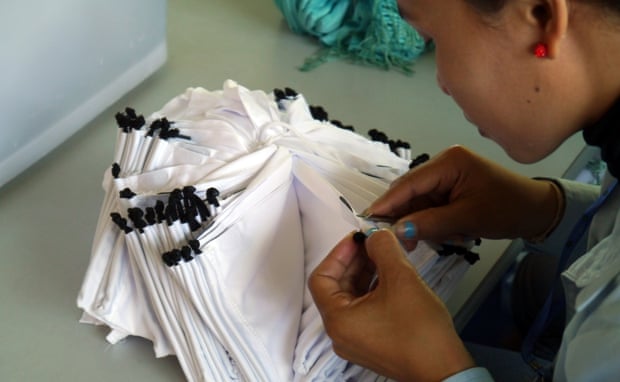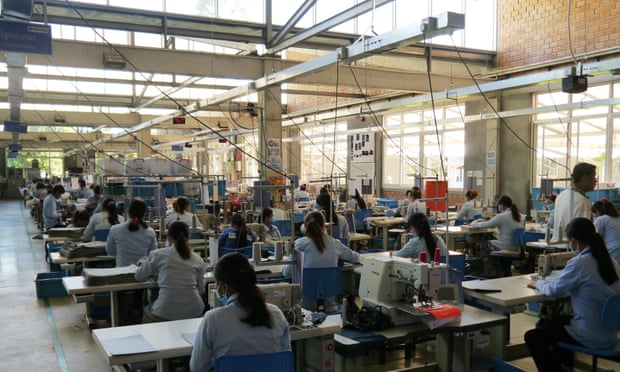Cambodian textile firm sewing the seeds of change
South-east Asia’s garment industry has a bad name but decent wages, childcare and labour rights are high priorities for one company breaking the mould
Workers at the Pactics factory in Cambodia
The Guardian
Sam Jones in Siem Reap
@swajones
Tuesday 29 December 2015
Piet Holten, a tall and ebullient mechanical engineer from the Netherlands, is fond of referring to Pactics as one of the best NGOs in Cambodia.
As he strides around its premises on a quiet, green plot on the outskirts of the tourist town of Siem Reap, his patter is peppered with references to sustainability, empowerment, development and opportunity.
But Pactics is not an NGO; after all, few NGOs would build themselves around a mission statement that aims “to create a decent company that offers competitively priced, high-quality microfibre products in an environmentally and socially responsible way”.
Nor, however, is it most people’s idea of a south-east Asian textile operation. Its factory has been designed by an architect and is arranged around a series of cooling courtyards. Its four buildings are designed to “harvest” daylight so there is no need for artificial light except during storms. Through the air above the waterlily-studded pond and the young trees being grown for shade, squadrons of dragonflies dart and dive.
Set up by Holten in Shanghai in 2004, Pactics began its Cambodian operations in 2010. Three years later, the Siem Reap factory was built; today it produces lens cloths and spectacle bags for the likes of Oakley, Tiffany and Ray-Ban.
Holten says he chose to build a factory far from the capital, Phnom Penh, after hearing stories of young women flocking to the city in search of work in the garment trade only to end up sleeping 12 to a room and facing debt and sexual exploitation.
“We believe a factory – even one that in terms of complexity is at the lower end of the manufacturing spectrum – can be very successful and competitive while at the same time making sure all people that contribute earn enough to properly support themselves and their [families],” he says.
The 320 people on the factory floor are divided into skilled and unskilled workers: the former are paid $125 a month plus 30% extra when targets are hit; the latter receive $125 a month plus 15%. Even if targets are not met, the company guarantees a basic wage of $125 a month and 44 days of paid holiday a year. In a country where the average annual income is just over $1,000 a head, such wages are highly sought after.
Pactics is, predictably, big on corporate social responsibility. Not only does the factory house a creche, a first-aid room staffed by a nurse, a lending library and a subsidised canteen, it contributes $50 a year towards the cost of each employee’s education and pays half the price of a crash helmet for its workers, most of whom, like the majority of Cambodians, rely on scooters for transport.
New employees receive five days of training, during which they are taught how to work safely, recognise their labour rights and identify sexual harassment. Workers are also free to form and join unions, although so far none has, according to Holten.
The factory’s toilets are flushed with rainwater and it has total wheelchair access for those who have lost limbs to landmines or traffic accidents. Holten likes to think of it as an unusually enlightened enterprise, but he is adamant he is still running a business.
“We believe that one very important factor of development and sustainability is for people to add value in a production process that produces for the world market,” he says.
“In other words, we create work that does not exist by the grace of a local tourist market full of goodwill or in a process that is subsidised. At Pactics, people earn their money contributing to the manufacturing of products that are sold on a very competitive world market.”
At the Siem Reap factory, which produces lens cloths and spectacle bags for leading brands, workers receive benefits such as help with the cost of education.
 |
| At the Siem Reap factory, which produces lens cloths and spectacle bags for leading brands, workers receive benefits such as help with the cost of education. Photograph: Sam Jones for the Guardian |
Chanthy Khun, a 31-year-old quality control supervisor at the factory, worked in a garment factory in Phnom Penh before moving to Siem Reap, where she and her husband ran a streetfood stall. Although the stall yielded a good income, it wasn’t always enough to get by on.
“During the high season, I could get three times what I get now but in the low season, we could only just survive,” she says. “I never want to go back to working in Phnom Penh. I feel proud because I get quite a lot of benefits and it’s close to where I live.”
This year, Pactics expects to make a 12% profit on a turnover of $8.5m, and Holten hopes its success will help persuade others to emulate it. But even a company like Pactics sometimes has difficulty in communicating the advantages of its model.
“We’re failing to explain the value of this to our customers,” he says. “That’s where we haven’t performed well.”
In the meantime, he adds, Pactics will keep doing what it does “because it’s fun: we are at the absolute bottom of the [garment trade] selling products that cost six cents. But we’re still showing that we can do things to improve people’s lives”.


No comments:
Post a Comment